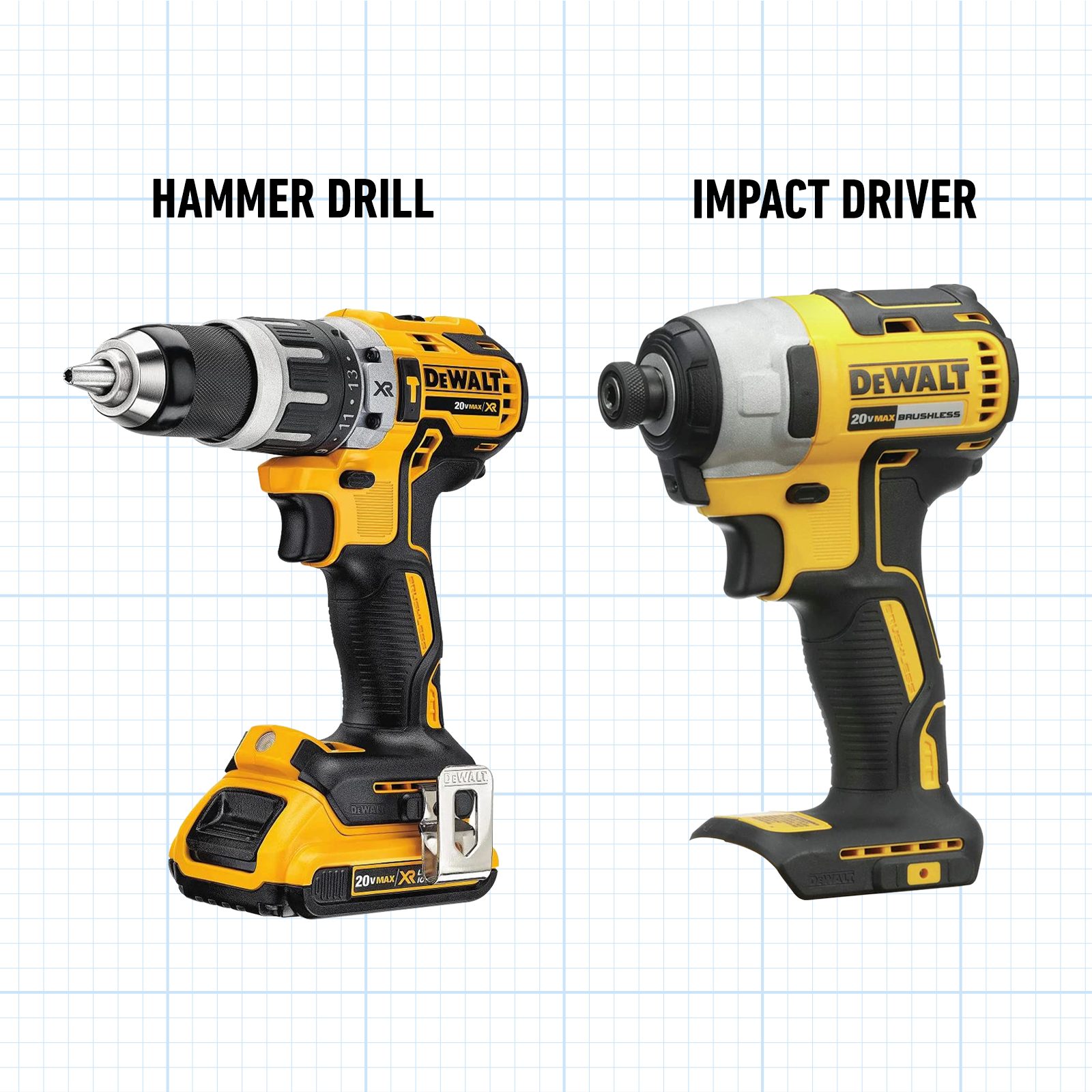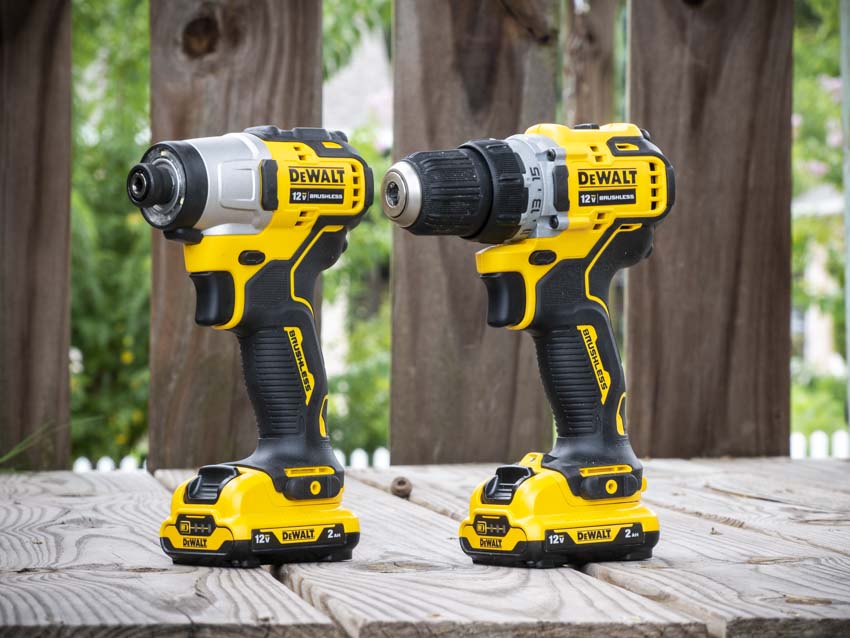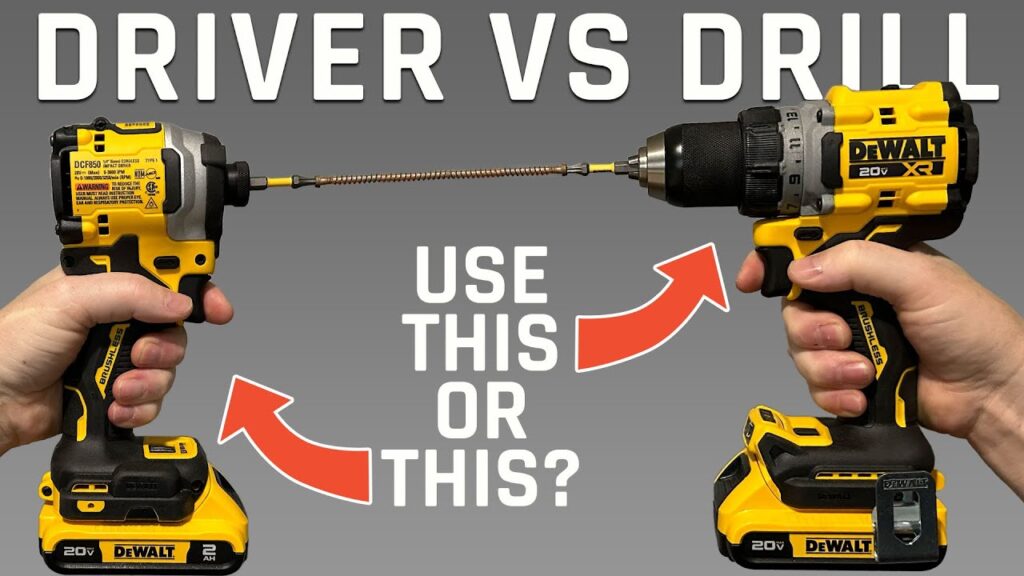Impact drills and impact wrenches serve different purposes. Impact drills are for drilling and fastening, while impact wrenches are for tightening and loosening bolts.
Impact drills are versatile tools used primarily for drilling holes and driving screws. They deliver rotational force combined with a hammering action, making them effective for tough materials like concrete and metal. Impact wrenches, on the other hand, are specialized for heavy-duty tasks such as automotive repairs and construction.
They provide high torque output, making it easier to tighten or loosen large bolts and nuts. Understanding the differences between these tools helps in selecting the right one for your specific needs, ensuring efficient and effective results in your projects.
Introduction To Impact Drill And Impact Wrench
Understanding the differences between an impact drill and an impact wrench helps in choosing the right tool. Both are power tools but serve unique purposes in various tasks.
Key Functions
Impact Drill: An impact drill is designed for drilling and driving screws. It uses rotational force combined with a hammering action. This helps in driving screws into tough materials.
Impact Wrench: An impact wrench delivers high torque output. It uses a rotational hammering mechanism. This makes it perfect for loosening or tightening nuts and bolts.
Primary Uses
| Tool | Primary Uses |
|---|---|
| Impact Drill |
|
| Impact Wrench |
|
Design Differences
Understanding the design differences between an impact drill and an impact wrench helps in choosing the right tool for the job. Below, we explore their physical characteristics and ergonomics.
Physical Characteristics
Impact drills and impact wrenches may look similar, but they have distinct differences in design.
| Feature | Impact Drill | Impact Wrench |
|---|---|---|
| Size | Usually smaller | Generally larger |
| Shape | More elongated | More compact |
| Weight | Lightweight | Heavier |
Ergonomics And Handling
Both tools are designed for specific tasks, affecting their ergonomics and handling.
- Impact Drill: Designed for drilling and driving screws.
- Impact Wrench: Designed for tightening and loosening bolts.
Impact Drill features a comfortable grip for extended use. Its lightweight design reduces user fatigue. The trigger is easy to control, providing precise drilling.
Impact Wrench has a robust grip to handle high torque. Its heavier build ensures stability during use. The trigger mechanism is designed for quick, powerful bursts.
Mechanical Operations
Understanding the mechanical operations of an impact drill and an impact wrench is key to choosing the right tool. These tools serve different purposes, and their mechanics differ significantly. Let’s dive into the details under two essential headings: Torque Production and Rotation Mechanism.
Torque Production
Torque is the twisting force that causes rotation. An impact drill and an impact wrench produce different torque levels.
- Impact Drill: Impact drills generate lower torque. They are perfect for drilling holes in materials like wood and metal.
- Impact Wrench: Impact wrenches produce high torque. They are ideal for loosening or tightening bolts and nuts.
In summary, if you need high torque, choose an impact wrench. For drilling, an impact drill is better.
Rotation Mechanism
The rotation mechanism of these tools affects their functionality.
- Impact Drill: Impact drills have a continuous rotation mechanism. This helps in drilling through hard surfaces efficiently.
- Impact Wrench: Impact wrenches use a hammering action. This mechanism provides bursts of force, making it easier to loosen tight bolts.
Each tool’s rotation mechanism is designed for specific tasks. An impact drill excels in drilling, while an impact wrench is best for loosening or tightening bolts.
Comparison Table:
| Feature | Impact Drill | Impact Wrench |
|---|---|---|
| Torque Level | Low | High |
| Rotation Mechanism | Continuous | Hammering |
| Best Use | Drilling | Loosening/Tightening Bolts |

Credit: m.youtube.com
Performance Capabilities
Understanding the performance capabilities of both an impact drill and an impact wrench is essential. This knowledge helps you choose the right tool for your tasks. Let’s compare their capabilities under two main aspects: power output and task efficiency.
Power Output
An impact drill typically offers a high rotational speed. This speed is measured in revolutions per minute (RPM). It is ideal for drilling holes into various materials.
On the other hand, an impact wrench delivers higher torque. This torque is measured in foot-pounds (ft-lbs). It is best suited for loosening or tightening nuts and bolts.
| Tool | Power Output |
|---|---|
| Impact Drill | High RPM |
| Impact Wrench | High Torque (ft-lbs) |
Task Efficiency
The task efficiency of an impact drill is evident in its versatility. It can drill into wood, metal, and even concrete with ease.
An impact wrench excels in tasks requiring high torque. It makes loosening stubborn bolts quick and effortless.
Consider the following task efficiency comparisons:
- Impact Drill: Best for drilling holes.
- Impact Wrench: Best for loosening and tightening bolts.
Choosing the right tool enhances your project’s efficiency. Always match the tool’s capabilities to your task requirements.
Suitable Materials And Applications
Choosing the right tool for your project is essential. Impact drills and impact wrenches have different strengths. Knowing their suitable materials and applications helps in decision-making.
Impact Drill Preferences
Impact drills are versatile tools. They work well with various materials. Here are some common materials and applications:
- Wood: Ideal for drilling holes in wooden surfaces.
- Metal: Suitable for creating holes in thin metal sheets.
- Plastic: Perfect for making precise holes in plastic items.
- Concrete: Can handle light-duty concrete tasks.
Impact drills are great for tasks like installing shelves, assembling furniture, and making pilot holes. Their versatility makes them a go-to tool for many DIY projects.
Impact Wrench Preferences
Impact wrenches excel in tasks requiring high torque. They are perfect for heavy-duty applications. Here are some common materials and uses:
| Material | Application |
|---|---|
| Automotive: | Removing and tightening lug nuts on vehicles. |
| Construction: | Fastening bolts and nuts in steel structures. |
| Heavy Machinery: | Maintenance and assembly of industrial machines. |
| Plumbing: | Loosening corroded or rusted pipes. |
Impact wrenches are essential for tasks needing strong torque. They are often used in automotive repair, construction, and heavy machinery maintenance.
Pros And Cons
Understanding the pros and cons of impact drills and impact wrenches helps in choosing the right tool for the job. Each has distinct advantages and disadvantages, making them suitable for different tasks.
Advantages Of Impact Drills
Impact drills offer several benefits:
- Versatility: Impact drills can handle various tasks, from drilling to driving screws.
- Compact Design: They are smaller and lighter, making them easier to use in tight spaces.
- Precision: Impact drills provide greater control for delicate tasks.
- Affordability: Generally, impact drills are less expensive than impact wrenches.
Advantages Of Impact Wrenches
Impact wrenches come with their own set of advantages:
- High Torque: They deliver more torque, ideal for loosening tough bolts.
- Speed: Impact wrenches can perform tasks faster, saving time and effort.
- Durability: Built to withstand heavy-duty tasks, impact wrenches are highly durable.
- Efficiency: They require less effort to operate, reducing user fatigue.
| Feature | Impact Drill | Impact Wrench |
|---|---|---|
| Torque | Lower | Higher |
| Size | Compact | Larger |
| Cost | Less Expensive | More Expensive |
| Best For | Drilling and Screwing | Loosening Bolts |
Compatibility With Attachments
Understanding the compatibility of impact drills and impact wrenches with various attachments is crucial. Different tasks require different tools and attachments. This section explores the types of attachments each tool can use, helping you choose the right tool for your needs.
Drill Bits And Drivers
Impact drills offer versatility with drill bits and drivers. These attachments allow you to drill holes and drive screws.
- Twist Drill Bits: These are used for drilling into wood, metal, and plastic.
- Spade Bits: Ideal for drilling larger holes in wood.
- Phillips Drivers: Perfect for driving screws with a Phillips head.
- Flathead Drivers: Used for screws with a flat head.
Impact drills can handle a wide range of tasks. This makes them a versatile choice for many users.
Sockets And Adapters
Impact wrenches are designed to work with sockets and adapters. These attachments are essential for tasks involving nuts and bolts.
| Attachment | Use Case |
|---|---|
| Standard Sockets | Used for tightening or loosening nuts and bolts. |
| Deep Sockets | Ideal for reaching bolts in deep spaces. |
| Universal Joints | Allows for flexibility in tight spaces. |
| Adapter Sets | Convert the wrench to fit different socket sizes. |
Impact wrenches excel in tasks that require high torque. They are indispensable in automotive and construction work.
Maintenance And Durability
Understanding the maintenance and durability of an impact drill and an impact wrench is crucial. This ensures they remain reliable and efficient tools in your toolkit. Proper care can extend their lifespan and maintain peak performance.
Care Instructions
Both impact drills and impact wrenches require regular cleaning. After each use, wipe the exterior with a clean cloth. Remove any debris from vents and moving parts.
Lubrication is key for impact wrenches. Apply a few drops of oil to the air inlet and run the tool for a few seconds. This spreads the oil throughout the internal parts.
For impact drills, check the chuck for debris. This can prevent smooth operation. Tighten and loosen it a few times to ensure it is clear.
Store both tools in a dry place. Keep them away from moisture to prevent rust and corrosion.
Longevity Factors
The longevity of your tools depends on several factors:
- Usage: Frequent use can wear out parts faster.
- Quality: High-quality brands tend to last longer.
- Maintenance: Regular cleaning and lubrication extend life.
- Environment: Use in harsh conditions can reduce lifespan.
Regular inspection is vital. Check for signs of wear and tear. Replace any worn-out parts immediately to prevent further damage.
| Tool | Key Maintenance | Durability Factors |
|---|---|---|
| Impact Drill | Clean, check chuck, store dry | Usage, quality, environment |
| Impact Wrench | Clean, lubricate, store dry | Usage, quality, environment |
By following these steps, you can ensure your tools last longer. This will save you money and frustration in the long run.
Cost Considerations
Cost considerations play a crucial role in deciding between an impact drill and an impact wrench. Understanding the initial investment and long-term value helps make an informed choice.
Initial Investment
The initial cost of purchasing an impact drill is generally lower. Many models are available for under $100. These drills are versatile and suitable for various tasks around the house. On the other hand, an impact wrench often costs more initially. Prices usually start around $150 and can go up to several hundred dollars for high-end models.
| Tool | Price Range |
|---|---|
| Impact Drill | $50 – $100 |
| Impact Wrench | $150 – $400+ |
Long-term Value
Long-term value is essential to consider. While an impact drill has a lower initial cost, it may not handle heavy-duty tasks. Frequent use for tough jobs can lead to quicker wear and tear. This may result in higher maintenance and replacement costs.
An impact wrench, though more expensive initially, offers better performance for heavy-duty tasks. Its durability often translates to fewer replacements and less maintenance over time. This can save money in the long run.
- Impact Drill: Lower initial cost, higher long-term maintenance
- Impact Wrench: Higher initial cost, lower long-term maintenance
Choosing between an impact drill and an impact wrench depends on your needs. Think about both the initial investment and the long-term value before deciding.

Credit: www.familyhandyman.com
Making The Right Choice
Choosing between an impact drill and an impact wrench can be tough. Both tools have specific uses. Making the right choice depends on your needs. Here, we’ll help you decide which tool suits you best.
User Skill Level
Your skill level matters when choosing a tool. Beginners might find an impact drill easier. It’s user-friendly and versatile. You can use it for basic tasks like drilling holes. On the other hand, an impact wrench requires more skill. It’s more powerful and used for heavy-duty tasks. If you’re experienced, you might prefer the wrench.
Project Requirements
Your project needs will also influence your choice. Here’s a simple table to help:
| Project Type | Recommended Tool |
|---|---|
| Drilling holes in wood or metal | Impact Drill |
| Driving screws into wood | Impact Drill |
| Loosening tight bolts or nuts | Impact Wrench |
| Automotive repairs | Impact Wrench |
For light tasks, use an impact drill. For heavy tasks, use an impact wrench. Make sure you choose the right tool for your project.
Safety Precautions
When using power tools like an impact drill or an impact wrench, safety precautions are vital. Misuse can lead to severe injuries. Below are essential safety measures for both tools.
Operational Safety
Operational safety ensures the correct and safe use of tools. Follow these steps:
- Read the manual: Understand your tool’s specific instructions.
- Inspect the tool: Check for any damage before use.
- Use correct settings: Set the right speed and torque for your task.
- Secure your workpiece: Ensure it is firmly held in place.
- Maintain a firm grip: Hold the tool securely to avoid slips.
Protective Gear
Wearing the right protective gear is crucial. Equip yourself with:
- Safety goggles: Protect your eyes from debris and dust.
- Ear protection: Use earplugs or earmuffs to prevent hearing damage.
- Gloves: Wear gloves to protect your hands from cuts and abrasions.
- Dust masks: Prevent inhalation of harmful particles.
- Steel-toed boots: Shield your feet from heavy falling objects.
Following these safety precautions ensures a safe working environment. Always prioritize safety to prevent accidents and injuries.
Future Of Power Tools
The world of power tools is rapidly evolving. Impact drills and impact wrenches are at the forefront. These tools are becoming smarter and more efficient. Let’s explore their future.
Technological Advances
Smart technology is transforming power tools. Impact drills and impact wrenches now have Bluetooth connectivity. This allows for remote control and monitoring.
Brushless motors are another big advancement. They make tools more powerful and long-lasting. Battery technology is also improving. Lithium-ion batteries now last longer and charge faster.
New safety features are being added too. Automatic shut-off and torque control help prevent accidents. These features make the tools safer to use.
Market Trends
The market for power tools is growing. DIY enthusiasts and professionals are both driving demand. Cordless tools are especially popular. They offer more flexibility and mobility.
There is also a move towards sustainable tools. Eco-friendly materials and energy-efficient designs are in demand. Consumers want tools that are good for the environment.
Price is another important factor. Affordable yet high-quality tools are winning the market. Companies are focusing on providing value for money.
| Feature | Impact Drill | Impact Wrench |
|---|---|---|
| Smart Technology | Yes | Yes |
| Brushless Motors | Yes | Yes |
| Battery Life | Long | Very Long |
| Safety Features | Advanced | Advanced |
| Price | Moderate | High |
- Remote control and monitoring are now possible.
- Brushless motors enhance power and durability.
- Lithium-ion batteries improve efficiency.
- New safety features are being integrated.
- Cordless tools are becoming the norm.
- Sustainable tools are gaining popularity.
- Consumers seek affordable, high-quality tools.

Credit: www.protoolreviews.com
Frequently Asked Questions
Which Is Better An Impact Drill Or An Impact Wrench?
An impact drill is best for drilling and driving screws. An impact wrench excels at loosening and tightening bolts. Choose based on your specific needs.
Can An Impact Wrench Be Used As A Drill?
No, an impact wrench cannot be used as a drill. It lacks the precision and control needed for drilling tasks. Use a proper drill for drilling.
Why Use A Drill Over An Impact?
A drill offers precise control and is ideal for making holes. It’s versatile for various materials and tasks.
Can I Use An Impact Driver To Remove Lug Nuts?
Yes, you can use an impact driver to remove lug nuts. Ensure it has sufficient torque and the correct socket.
Conclusion
Choosing between an impact drill and an impact wrench depends on your specific needs. Both tools offer unique advantages. An impact drill is ideal for drilling and driving screws. An impact wrench excels in heavy-duty tasks like loosening bolts. Evaluate your projects to make the best decision for efficiency and effectiveness.


